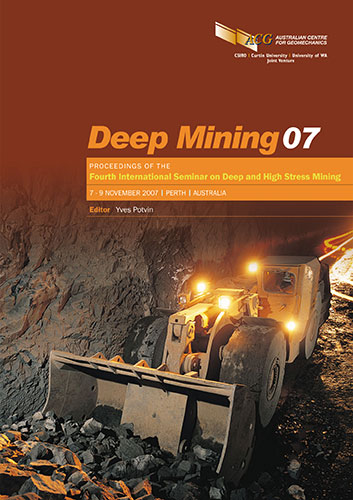Accounting for the Effect of Rock Mass Anistropy in Stress Measurements

|
Authors: Dight, PM; Dyskin, AV |
DOI https://doi.org/10.36487/ACG_repo/711_30
Cite As:
Dight, PM & Dyskin, AV 2007, 'Accounting for the Effect of Rock Mass Anistropy in Stress Measurements', in Y Potvin (ed.), Deep Mining 2007: Proceedings of the Fourth International Seminar on Deep and High Stress Mining, Australian Centre for Geomechanics, Perth, pp. 415-424, https://doi.org/10.36487/ACG_repo/711_30
Abstract:
Safety and efficiency of mining operations depend on the quality of design of mining excavations and sequence. A crucial ingredient in mining design is the adequate information of both the original in situ stress and the stress disturbance caused by mining. The main method of stress determination – the overcoring – has a number of drawbacks. 1. It requires an open access to the location of the measurements, which is especially difficult if the stress is to be measured ahead of deep underground excavation. 2. It presumes the rock to be isotropic, while in many cases the rock anisotropy is significant. Subsequently, the isotropic stress reconstruction procedure of the overcoring method can give erroneous stress magnitudes and directions (e.g. Amadei and Goodman, 1982). The rock memory methods - DRA and the Kaiser effect are free from the influence of anisotropy. Moreover the DRA technique can, in principle, provide as a by-product a sufficient number of measurements to reconstruct the full anisotropic tensor of moduli, or compliances sufficient to characterise rock anisotropy, introduce corrections to the overcoring stress reconstruction procedure and quantify the effect of rock anisotropy on the stress concentrations induced by the excavation. In this paper, we present the procedure for the anisotropy characterisation based on DRA and analyse the sensitivity of the procedure and the effects of the rock anisotropy on stress measurements.
References:
Amadei, B. (1996) Importance of anisotropy when estimating and measuring in-situ stress in rock. Int. J. Rock Mech.
Min. Sci. Vol. 33(3), pp. 293-325.
Amadei, B. (1983) In: C.A. Brebbia and S.A. Orszag (eds) Lecture notes in engineering - rock anisotropy and theory of
stress measurements. Springer Verlag, Berlin, pp. 233-41.
Amadei, B. and Goodman, R.E. (1982) The Influence of Rock Anisotropy on Stress Measurements by Overcoring
Techniques, Rock Mechanics, Vol. 15, pp. 167-180.
Barr, S.P., Jupe, A.J. and Hunt, D.P. (1999) The Kaiser effect for samples pre-stressed at 820 m and 2.4 km with stress
tensor results. Proceedings 9
th
Int. Cong. Rock Mech. 28, pp. 1136-1143.
Dight, P.M. (2006) Determination of Insitu Stress from Oriented Core. Proceedings International Symposium on In-situ
Rock Stress, Trondheim, Norway, pp. 167-175.
Goodman, R.E. (1963) Subaudible noise during compression of rocks. Bull. Geol. Soc. Am. Vol. 74, pp. 487-490.
Hakala, M., Kuula, H. and Hudson, J.A. (2007) Estimating the transversely isotropic elastic intact properties for in-situ
stress measurement data reduction: A case study of the Olkiluoto mica gneiss, Finland. Int. Jnl. Rock Mechanics
and Mining Sciences, Vol. 44, pp. 14-46.
Kaiser, J. (1950) An investigation into the occurrence of noises in tensile tests or a study of acoustic phenomena in
tensile tests. PhD. Thesis. Tech Hochschule, Munich, Germany.
Kaiser, J. (1953) Erkenntnisse und Folgerungen aus der Messung von Gerauschen bei Zugbeanspruchung von
Metallischen Werstoffen. Archiv Eisenhuttenwesen, Vol. 24, pp. 43-45.
Lavrov, A. (2002) The Kaiser effect in rocks: principles and stress estimation techniques. Int. Jnl. Rock Mech. Min. Sci.
Vol. 40, pp. 151-171.
Kurita, K. and Fujii, N. (1979) Stress memory of crystalline rocks in acoustic emission. Geophys Res Lett. Vol. 6, pp.
9-12.
Leeman, E.R. (1965a) The measurement of stress in rock. Part I. The principles of rock stress measurements. Jnl of
South African Institute of Mining and Metallurgy, pp. 248-284.
Leeman, E.R. (1965b) The measurement of stress in rock. Part II. Borehole rock stress measuring instruments. Jnl of
South African Institute of Mining and Metallurgy, pp. 285-317.
Leeman, E.R. (1965c) The measurement of stress in rock. Part III. The results of some rock stress investigations. Jnl of
South African Institute of Mining and Metallurgy, pp. 318-374.
Lekhnitskii, S.G. (1977) Theory of Elasticity of an Anisotropic Body. Mir, Moscow.
Lim, S.S., Martin C.D. and Christiansson, R. (2006) Estimating in-situ stress magnitudes from core disking.
Proceedings International Symposium on In-situ Rock Stress, Trondheim, Norway, pp. 159-166.
Meyer, A.G., Hunt, S.P. and Oliver, K.J. (2002) The use of the DRA Technique and Porosimetry for Estimating the
Maximum In-situ Stress in Rock from Core. Australian Geomechanics Journal, Vol. 37(1), pp. 17-22.
Seto, M. and Villaescusa, E. (1999) In-situ Stress Determination by Acoustic Emission Techniques from McArthur
River Mine Cores. Proc 8
th Aust. NZ. Conf. Geomech, Hobart, Vol. 2, pp. 929-934.
Villaescusa, E., Windsor, C., Li, J., Baird, G. and Seto, M. (2003) Stress Measurements from cored rock. MERIWA
Report M329.
Worotnicki, G. (1993) CSIRO triaxial stress measurement cell. In J.A. Hudson (editor), Comprehensive Rock
Engineering, Vol. 3, Pergamon Press, Oxford, pp. 329-394.
Yamamoto, K., Kuwahara, Y., Kato, N. and Hirasawa, T. (1990) Deformation rate analysis: a new method for in-situ
stress estimation from inelastic deformation of rock samples under uniaxial compression. Tohoku Geophysical
Journal Vol. 33, pp. 1-13.
Yamamoto, K. (1995) The rock property of in-situ stress memory: Discussions on its mechanism. Int. Workshop on
Rock Stress: Measurements at Great Depth. Matsuki and Sugawara (eds), 8
th
ISRM, Tokyo, Sept 35-30,
pp. 46-51.
Yamamoto, K., Yamamoto, H., Kato, N. and Hirasawa, T. (1991) Deformation Rate Analysis for In Situ Stress
Estimation, 5
th
Int. Conf. on Acoustic Emission/Microseismic Activity in Geologic Structures and Materials –
Pennsylvania State University, 11-13 June, pp. 243-255.
Accounting for the Effect of Rock Mass Anisotropy in Stress Measurements P.M. Dight, A.V. Dyskin
424 Deep Mining 07, Perth, Australia
© Copyright 2025, Australian Centre for Geomechanics (ACG), The University of Western Australia. All rights reserved.
View copyright/legal information
Please direct any queries or error reports to repository-acg@uwa.edu.au
View copyright/legal information
Please direct any queries or error reports to repository-acg@uwa.edu.au